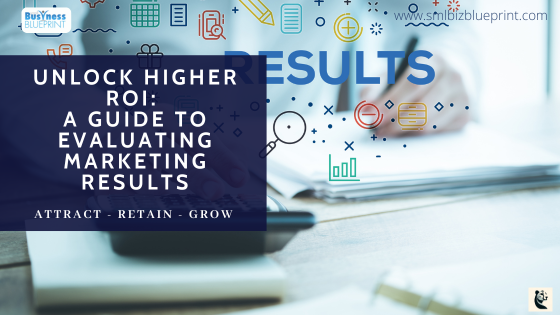In today’s fast-paced digital landscape, it’s easy to launch campaign after campaign without stopping to reflect on whether your marketing efforts are actually moving the needle.
You might be generating leads, gaining followers, or driving website traffic—but how do you know if your marketing outcomes truly deliver the return on investment (ROI) your business needs?
Many businesses struggle to determine which campaigns are working and which are failing. According to HubSpot, 40% of marketers say proving the ROI of their marketing activities is their biggest challenge.
You’re not alone if you feel like you’re spending time and resources without a clear picture of what’s driving results.
This guide will help you evaluate your marketing outcomes effectively, identify the right metrics to track, avoid common mistakes, and use data to drive smarter decisions. By the end of this post, you’ll have the tools and insights you need to fine-tune your marketing strategy and maximise your ROI.
Let’s dive into how to turn those marketing efforts into measurable success.

#1 Why Evaluating Your Marketing Outcomes Is Essential for Growth
Marketing isn’t just about launching campaigns and hoping for the best. If you aren’t consistently evaluating your marketing outcomes, you could be missing out on valuable insights that can drive your business forward.
Without proper evaluation, it’s impossible to know whether your marketing activities contribute to growth or simply consume time and resources.
What Are Marketing Outcomes?
Marketing outcomes are the measurable results generated from your marketing efforts. These could be leads, sales, website traffic, social media engagement, or other key performance indicators (KPIs) tied to your business objectives.
Tracking these outcomes allows you to gauge how well your campaigns are performing and whether they’re helping you meet your business goals.
The Importance of Regular Evaluation
Regularly assessing your marketing outcomes is crucial for identifying what works and what doesn’t. It’s easy to get caught up in the excitement of new marketing tactics, but if they aren’t delivering results, they’re ultimately a drain on resources.
Businesses that continuously evaluate and optimise their marketing outcomes are more agile and able to adjust their strategies based on real-time insights, ensuring a higher return on investment (ROI).
Data-Driven Decision Making
Evaluating outcomes helps you move beyond gut feelings and make data-driven decisions. For example, if one of your campaigns generates leads but few conversions, analysing that outcome can help you pinpoint improvement areas, such as your landing page or follow-up strategy.
This data-driven approach leads to more effective marketing and better results over time.
According to a Gartner report, companies that regularly evaluate and adjust their marketing outcomes experience a 20% increase in overall performance compared to those that don’t.
This highlights the importance of making marketing evaluation a continuous process.
By prioritising the evaluation of your marketing outcomes, you can ensure your efforts are aligned with your business goals, improve your ROI, and position your brand for sustainable growth.
#2 Key Metrics to Measure the Success of Your Marketing Efforts
To truly understand the effectiveness of your marketing campaigns, you need to track the right metrics. These key performance indicators (KPIs) offer insights into how well your efforts resonate with your target audience and contribute to business growth.
Here are the most important metrics to consider when evaluating your marketing outcomes.
Conversion Rate
Conversion rate measures the percentage of visitors who take a desired action, such as filling out a form, making a purchase, or signing up for a newsletter.
It’s one of the most critical metrics because it directly reflects the effectiveness of your marketing efforts in turning leads into customers.
A high conversion rate means your messaging, offers, and user experience are aligned with your audience’s needs.
Customer Acquisition Cost (CAC)
CAC calculates the total cost of acquiring a new customer, including marketing and sales expenses. It’s essential for understanding the financial efficiency of your marketing strategy.
If your CAC is too high, it could cut your profit margins.
Lowering your CAC improves profitability, making your marketing budget go further.
Customer Lifetime Value (CLV)
CLV measures the total revenue a business can expect from a customer over the duration of their relationship. When you track CLV in conjunction with CAC, you gain a better understanding of the long-term profitability of your marketing efforts.
Increasing CLV means you’re retaining customers for longer, and they’re providing more value to your business over time.
Return on Investment (ROI)
ROI compares the revenue generated from your marketing campaigns to the costs of executing those campaigns. It’s the ultimate measure of success because it tells you whether your marketing delivers a positive return.
A strong ROI shows that your marketing spend drives substantial growth and profitability.
Engagement Metrics
Metrics like click-through rates (CTR), social media shares, and email open rates reflect how well your content engages your audience. While engagement metrics aren’t directly tied to revenue, they’re leading indicators of your content’s effectiveness in building brand awareness and interest.
High engagement indicates that your audience is interested in your content and willing to interact with your brand, which can lead to future conversions.
By tracking these key metrics, you’ll gain valuable insights into the success of your marketing efforts. This will enable you to make data-driven adjustments and optimize your strategy for better performance and ROI.
#3 Tools and Techniques for Tracking Marketing Performance
To evaluate your marketing outcomes effectively, you need the right tools and techniques to track performance across different channels. By leveraging these tools, you can gather data, measure success, and make informed decisions to optimise your marketing strategies.
Here are some of the most valuable tools and techniques to consider.
Google Analytics
Google Analytics is essential for tracking website traffic, user behaviour, and conversion rates. It helps you understand which sources drive the most traffic, how visitors interact with your site, and where they drop off in the sales funnel.
Google Analytics provides comprehensive insights into your digital marketing performance, allowing you to optimise your website for better user experience and conversions.
CRM Software
Customer relationship management (CRM) software tracks customer interactions, helping you monitor leads, conversions, and customer journeys across different touchpoints.
CRMs allow you to measure the success of your campaigns by tracking the number of leads that convert into customers and at what stage of the sales funnel.
A CRM provides a 360-degree view of your customers, enabling you to identify the most effective marketing efforts and improve lead nurturing.
Social Media Analytics Tools
For businesses active on social media, platforms like Facebook Insights and Instagram Analytics offer detailed reports on audience engagement, reach, and content performance.
These tools help you understand which types of content resonate with your audience and how your social media presence contributes to overall marketing outcomes.
Social media analytics give you actionable data on how well your content is performing and how to engage your target audience better.
Marketing Automation Platforms
Marketing automation tools help you track and measure the performance of automated campaigns, such as email marketing and lead nurturing. These platforms provide insights into email open rates, click-through rates, and customer journeys, enabling you to refine your approach based on real-time data.
Automation tools streamline your marketing efforts and offer valuable data on campaign performance, allowing you to optimize your outreach.
Heatmap Tools
Heatmap tools allow you to visually track where users click, scroll, and spend time on your website. This data helps you understand how visitors interact with your pages, revealing areas where you can improve layout, calls to action, or overall user experience.
Heatmaps provide a clear visual representation of user behaviour, enabling you to optimise page design for better engagement and conversions.
A/B Testing Tools
A/B testing tools allow you to test different variations of your website, landing pages, or emails to determine which version performs better. You can incrementally improve your marketing outcomes by testing small changes—such as headline copy or call-to-action buttons.
A/B testing ensures you’re making data-driven decisions based on what resonates best with your audience, leading to higher conversion rates.
According to Forrester, businesses that fully leverage data and analytics tools can increase their marketing ROI by up to 15-20%. By using these tools to track and measure marketing performance, you can continuously refine your strategies for better results.
By incorporating these tools into your marketing workflow, you’ll gain deeper insights into how your campaigns are performing.
This will allow you to make more informed decisions and achieve better outcomes over time.

#4 Common Mistakes to Avoid When Assessing Your Marketing Results
While evaluating your marketing outcomes is essential for growth, common mistakes can lead to inaccurate assessments or missed opportunities for improvement.
Avoiding these pitfalls will ensure you make the most of your data and optimise your strategy for better results.
Below are some key mistakes to watch out for and how to avoid them.
Focusing Only on Vanity Metrics
Vanity metrics like social media likes, impressions, or follower counts can be misleading. While they may show that your content is being seen, they don’t necessarily reflect meaningful engagement or conversions.
Measuring success through metrics directly tied to business objectives—such as conversions, ROI, or customer lifetime value (CLV)—is far more valuable.
Avoid over-prioritizing vanity metrics and focus on actionable metrics that drive revenue and growth.
Not Tracking Goals Consistently
One of the most common mistakes businesses make is failing to track their goals consistently over time. Inconsistent tracking can lead to missed opportunities and flawed data analysis, making it difficult to understand what drives your results.
Setting up automated reporting and regularly reviewing your KPIs ensures you’re monitoring real-time performance.
Consistent tracking is key to accurate evaluation. Set up regular reports and stick to them to avoid gaps in your data.
Ignoring Qualitative Feedback
While quantitative data like conversion rates and ROI are critical, ignoring qualitative feedback from your customers is a mistake. Customer reviews, social media comments, and direct feedback can provide valuable context behind the numbers.
Understanding why customers behave a certain way is as important as understanding what they do.
Combine quantitative data with qualitative insights to get a complete picture of your marketing outcomes.
Failing to Adjust Based on Results
Many businesses gather data but fail to act on it. Collecting metrics without making changes or optimisations based on the results is a missed opportunity.
Regularly reviewing your marketing outcomes should lead to actionable steps that help you refine and improve your strategy.
Data should drive decisions. Use the insights you gather to optimise your marketing efforts and continuously achieve better results.
Overlooking the Importance of Segmentation
Evaluating your marketing results without segmenting your audience can obscure important insights. Different customer segments behave differently, and one-size-fits-all evaluations can lead to inaccurate conclusions.
Use audience segmentation to track the performance of specific groups, such as new vs. returning customers or different geographic locations.
Segmentation helps you understand how different audiences respond to your marketing efforts, allowing for more targeted and effective campaigns.
According to MarketingProfs, 46% of marketers admit they don’t regularly assess or adjust their marketing strategies based on data. Businesses that regularly avoid these common mistakes and act on their marketing insights report 10-20% improvements in campaign effectiveness.
By avoiding these common pitfalls, you can ensure that your marketing evaluations are accurate and actionable.
This will help you continuously improve your strategy, optimise for better results, and achieve a higher return on your marketing investment.
#5 Real-Life Applications
To truly understand the value of evaluating marketing outcomes, let’s look at some applications businesses can use to make data-driven decisions to optimise their campaigns and significantly improve their ROI.
Increasing Lead Generation
As a small business, you may find that your generic email marketing campaigns are not driving the desired results. Evaluate your email open rates and conversion metrics to understand if your message resonates with your audience.
Segment your email list and create personalised campaigns based on customer behaviour and preferences.
Personalisation based on data insights can significantly boost email performance and customer engagement.
Lowering Customer Acquisition Cost (CAC) through Retargeting Ads
You may struggle with high customer acquisition costs (CAC), which cut your profit margins. Analysing your marketing outcomes to learn if your broad targeting strategy is working.
Experiment with implementing retargeting ads on social media platforms, focusing on users who have visited your website but have not converted.
Optimising ad targeting based on customer behaviour can reduce acquisition costs and boost sales efficiency.
Improving Customer Lifetime Value (CLV)
You may acquire new customers, but your low retention rates lead to a lower-than-expected customer lifetime value (CLV). Evaluating your customer feedback and usage data to learn where customers drop off in your sales process.
This will help identify areas that your business needs to improve.
Focusing on customer retention through better understanding and feedback can drive long-term value and profitability.
A/B Testing and Content Optimization
If you want to improve the performance of your landing pages and lead generation forms, run A/B tests. By testing headlines, CTAs, and form lengths, you can identify which elements have the greatest impact on conversions.
A/B testing small elements in your marketing campaigns can lead to big improvements in performance and ROI.
Lessons
- Segmentation and Personalization: Tailoring marketing efforts based on customer preferences and behaviours leads to higher engagement and conversions.
- Retargeting: Retargeting ads can efficiently lower customer acquisition costs and maximize your ad spend.
- Onboarding and Retention: Improving customer experience at key touchpoints like onboarding can increase retention and CLV.
- A/B Testing: Experimenting with small changes in your marketing materials can result in meaningful improvements in conversion rates and overall ROI.
According to Invesp, companies that adopt a data-driven marketing approach are 6x more likely to be profitable year over year than those that don’t. Continuously evaluating and optimising marketing outcomes can significantly improve ROI and overall business performance.
By strategically evaluating your marketing efforts, you can achieve better results, lower costs, and drive long-term growth.
#6 How to Use Data Insights to Refine and Improve Future Campaigns
Evaluating your marketing outcomes is just the beginning. To see real, long-term improvement, you must use the data insights gained from your evaluations to refine future campaigns.
Data-driven marketing allows you to optimise your strategy, target the right audiences, and make informed decisions that drive better results.
Let’s explore how to turn those insights into actionable steps for continuous improvement.
Analyse Past Campaign Data
The first step in refining your future marketing efforts is analysing past campaigns’ data. Look at conversion rates, ROI, customer acquisition costs (CAC), and customer lifetime value (CLV).
Identify positive and negative trends and determine which tactics and channels delivered the best results.
Historical campaign data provides valuable insights into what works and what doesn’t, allowing you to focus your future efforts on high-impact strategies.
Set Clear, Measurable Goals for Future Campaigns
To ensure data guides your future campaigns, it’s crucial to set SMART goals— Specific, Measurable, Achievable, Relevant, and Time-bound.
Define the specific outcomes you want to achieve, such as improving your conversion rate by 10%, reducing your CAC, or boosting your email open rates.
Clear goals ensure that your marketing efforts are focused and that you have a benchmark against which to measure future success.
Implement A/B Testing and Experimentation
One of the most effective ways to improve your future marketing campaigns is through A/B testing. You can determine which variations perform best by testing different elements of your campaigns—such as subject lines, landing page designs, or ad copy.
This process allows you to continuously optimise based on real-time data rather than relying on assumptions.
A/B testing helps you make data-driven decisions, leading to higher conversion rates and more effective marketing.
Refine Audience Targeting with Segmentation
Data can reveal valuable insights about your target audience’s preferences, behaviour, and engagement patterns. Use this information to create more targeted and personalised campaigns.
By segmenting your audience based on demographics, behaviour, or purchasing history, you can deliver more relevant messaging that resonates with each group.
Audience segmentation allows for more precise targeting, leading to better engagement and higher conversion rates.
Continuously Monitor Performance and Make Adjustments
Once your campaign is live, continuous monitoring of its performance is essential. Use tools like Google Analytics, CRM software, and marketing automation platforms to track your progress toward the goals you’ve set.
If certain tactics aren’t delivering the desired results, be agile and make adjustments in real time.
Marketing is an ongoing process. Regularly reviewing and refining your campaigns ensures they stay effective and align with your business goals.
Leverage Cross-Channel Insights
Today’s marketing landscape is multi-channel, with customers interacting with your brand across social media, email, websites, and more. Use insights from one channel to refine and enhance performance across others.
For example, if you notice that certain types of blog content perform well on social media, you can repurpose that content for email marketing or paid ads.
Applying insights across multiple channels can create a cohesive, data-driven marketing strategy that maximises reach and engagement.
According to Forrester Research, companies that leverage data-driven marketing strategies are 23 times more likely to acquire new customers and 6 times more likely to retain existing ones.
This underscores the importance of using data to evaluate past performance and continuously improve future marketing efforts.
Using data insights to refine and optimise your campaigns, you can create more targeted, efficient, and successful marketing strategies.
Whether you’re improving audience segmentation, testing new approaches, or refining your content, data-driven decisions are key to driving better marketing outcomes over the long term.
Conclusion
Evaluating your marketing outcomes is not a one-time task—it’s a continuous process that enables you to fine-tune your strategies and drive meaningful results.
By tracking key metrics like conversion rates, customer acquisition costs (CAC), and customer lifetime value (CLV), you gain valuable insights into your campaigns’ performance.
Leveraging the right tools and avoiding common mistakes, such as focusing too much on vanity metrics or ignoring qualitative feedback, allows you to make data-driven decisions that improve efficiency and ROI.
Regular evaluation and optimisation lead to sustained growth and long-term success.
Whether you use A/B testing to refine your strategies or personalise your marketing campaigns for better targeting, the insights you gain from your data can transform your marketing efforts.
It’s time to take action. Start evaluating your marketing outcomes today and use the insights to optimise your strategies for better performance.
Whether you’re a small business or a growing enterprise, regularly reviewing and refining your marketing efforts will lead you to success.
Ready to start driving better results? Begin by implementing these strategies and watch your ROI soar!
You can transform your marketing outcomes into powerful growth tools by continuously improving and staying data-focused. Let the data guide you to smarter decisions and greater success.
FAQs
Q1: Why is it important to regularly evaluate marketing outcomes?
A1: Evaluating marketing outcomes helps you understand how well your campaigns are performing, ensuring that you allocate resources effectively. Regular assessments allow you to make data-driven decisions, improve ROI, and refine future strategies to drive long-term growth.
Q2: What are the most important metrics to track for marketing success?
A2: Key metrics include conversion rate, customer acquisition cost (CAC), customer lifetime value (CLV), return on investment (ROI), and engagement metrics like click-through rates (CTR) and social shares. These metrics offer insight into the effectiveness of your marketing efforts.
Q3: What tools can I use to evaluate my marketing outcomes?
A3: Tools like Google Analytics, CRM platforms, social media analytics tools, and marketing automation software are essential for tracking performance and gathering valuable data.
Q4: What are common mistakes businesses make when evaluating marketing outcomes?
A4: Common mistakes include focusing too much on vanity metrics, inconsistent tracking, ignoring qualitative feedback, failing to act on data insights, and not segmenting the audience. Avoiding these pitfalls ensures a more accurate evaluation of your marketing efforts.
Q5: How can A/B testing improve my marketing outcomes?
A5: A/B testing allows you to test different variations of your campaigns, such as headlines or CTAs, to see which performs better. By making data-driven changes based on these results, you can optimize your campaigns for higher conversions and better results.
Q6: How often should I review my marketing performance?
A6: It’s recommended to review your marketing performance at least quarterly, but monthly reviews are ideal for staying agile and making quick adjustments. Real-time monitoring of key metrics can help you make timely decisions and improve campaign outcomes.
Q7: How can I use data insights to improve future campaigns?
A7: By analysing past campaign data, setting clear goals, and using techniques like audience segmentation and A/B testing, you can continuously refine your marketing strategies. Data insights help you target the right audience, optimise ad spend, and improve conversion rates.
Other Articles
The Ultimate Guide to Building a Powerful KPI Dashboard
Discover Key Steps to Improve Your Marketing Workflows
Essential KPI Dashboard Elements for Smarter Business Growth




